Fire Escape Ladder Information
Fire escape ladders are portable or retrospectively fitted fire escape devices. This distinguishes them from fire escapes, which is the term typically applied to the escape routes installed when a building or extension is constructed from new. Traditionally, fire escape ladders consist of hooks to anchor the ladder on the wall underneath a window, with the ladders themselves being made of rope, chain or metal wire connected to the hooks. Some escape ladders, however, are clipped onto eye bolts or metal bars that are permanently fitted to the wall. More advanced fire escape ladders are permanently installed in the cavity wall of a building or fitted as fold-out ladders to an outside wall.
Where are fire escape ladders used?
Fire escape ladders are fitted where there is the chance that an existing escape route (e.g. a staircase) can become blocked by fire, with no alternative means of escaping. While all modern buildings have fire escape windows (i.e. windows that open up fully to accommodate evacuees), these still rely on the fire services arriving in time to rescue those who are obliged to wait their turn at the window. On the other hand, most private homes, to give one example, will benefit from having fire escape ladders fitted as these offer a secondary escape route without relying on the fire services.
In commercial premises, fire escape ladders can address the problem of insufficient provision of fire escapes identified through the fire risk assessment. If, for example, office blocks of up to ten metres in height have segments that can become cut off from escape routes through fire, fire escape ladders can be a feasible means of creating a secondary escape route. This depends, however, on the profile of people in the building; are they all able-bodied, are there members of the public as well, etc. Fire escape ladders are usually not permitted as an alternative escape route in new buildings.
The most acceptable type of escape ladder in commercial buildings, especially in any historic building, is the externally installed fold-out escape ladders that can be produced in any colour to match the existing colour scheme.
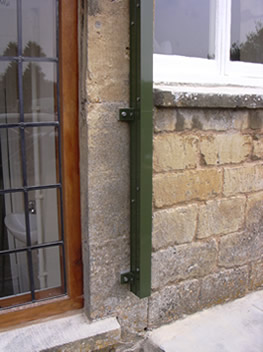
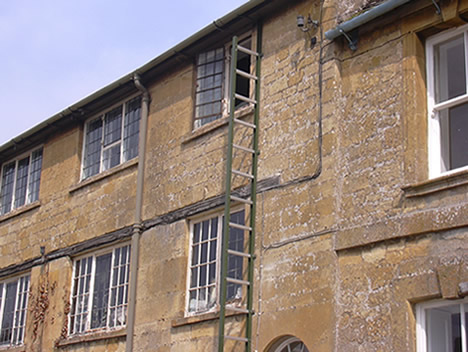
When in doubt, advice should be sought either from the local authority (e.g. in the case of HMOs) or the fire risk assessor.
What does legislation say about fire escape ladders?
New buildings must observe the Building Regulations, which define the number and design of escape routes required. Businesses, landlords and home owners are of course free to add fire escape ladders in addition to the requirements of the Building Regulations.
For existing business premises, the various fire risk assessment guidelines for different industries offer general guidance on escape routes. However, businesses will have to make a judgement about the suitability of fire escape ladders in their particular situation and will have to justify this decision to the fire services in case of an inspection.
There are some additional guidelines for the rented sector, of which the local authority will be able to advise in respect of appropriate fire escape solutions.
If in doubt, we always recommend that you consult the relevant authorities first before purchasing fire escape ladders.
Which fire escape ladder models are available?
Portable escape ladder with hook
The most traditional of fire escape ladders has a 'C'-shaped hook which is placed over the window sill and wall of a window.
The ladder itself is then lowered out of the window. It is essential that the rungs of the ladder have what is called 'distance pieces': little struts that keep the rungs away from the wall to ensure a good foothold.
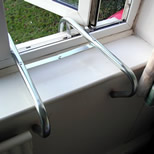
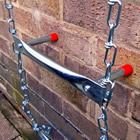
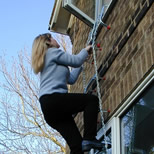
The ladder shown, a Saf-Escape ladder, is made of zinc plated steel chain and steel rungs. Many standard fire escape ladders that are designed for the US market are unsuitable for the thicker walls of buildings in the UK. The Saf-Escape ladder, however, comes in various hook sizes to ensure that the ladder can adapt to the wall it is intended for. It is important to ensure that you select a hook that fits perfectly over your wall. If the hooks are too small, it is possible that the hook will only grip the window sill, which will not be strong enough to support the weight of a person.
Hook escape ladders of this type are mainly used in domestic buildings.
Portable with carabiner hooks
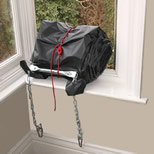
If you have unusually shaped walls or require an easier and faster deployment, the hooks on some models are replaced with carabiner hooks. In the event of an emergency, the ladder is hooked onto eyebolts, which are permanently fixed to the internal wall underneath the window. This allows you to deply the fire escape ladder without the concern of selecting a hook size suitable for your wall thickness.
The EasyScape is mainly used in domestic buildings.
Portable escape ladder with wall bar
An alternative to the eyebolts is the installation of a strong metal bar. Kletterfix escape ladders then hook over the bar. The Kletterfix is very compact, although one has to be aware that the ladder is folded rather intricately, with every second rung spun by 180 degrees. This ensures that the steel wire with which the ladder is constructed is kept tense. The ladder is therefore not suitable for regular practice evacuations, as reassembly is a lengthy process.
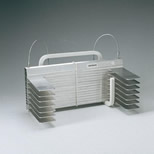
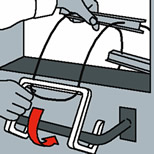
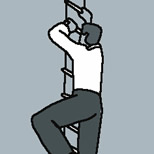
The Kletterfix is mainly used in domestic buildings.
Escape from angled loft windows and dormer windows
To ensure that your escape ladder safely deploys over an angled roof, the ladder must unroll by itself. The only escape ladder models capable of this are the Rollo and the EasyScape ladders. The Rollo and the EasyScape fire escape ladders feature a protective backing sheet, designed to prevent the rungs from catching in guttering and other obstructions whilst being unrolled.
Fold-out escape ladders fitted to the outside
One of the safest fire escape ladders and the ladder most suitable for installation in business premises is the Saffold fold-out fire escape ladder. The ladder, when not deployed, is drainpipe sized and bolted on the outside wall. In an emergency, a pin is drawn at the top and the ladder opened up. The ladder is exceptionally strong and virtually impossible to overload. It is guaranteed for 15 years and is easy to fit. If required, harnesses can be supplied that slide down with the user but stop any fall. The ladders are available in any colour and are the escape ladder of choice for any historic building.
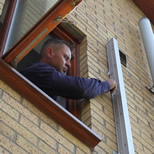
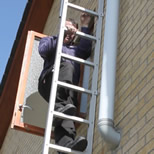
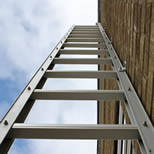
The Saffold ladders are supplied with a self-adhesive, glow-in-the-dark instruction sign.
The ladder is perfect for both business and domestic use.
Descenders / fall arrest equipment
For unusual buildings or where children / the elderly have to be lowered to the ground safely, descenders or fall arrest equipment can be used. A descender drum is fitted at window height with a rope or wire running through the drum. The person to be rescued is fitted in a harness to one end of the rope and lifted out of the window (transport bags are used for very small children). The drum of the descender will then lower the load to the ground at a steady and safe speed. Once the first person has landed safely, the next person can be attached to the other end of the rope and lowered down. There is no limit to the number of people being lowered to the ground. It is important, though, to remember that the first person 'landing' must be able to undo their harness and also provide assistance to any disabled and / or very young people subsequently lowered by the descender.
This escape system is mainly used where small children or immobile people have to be rescued. It can also be used on cranes and other industrial structures of substantial height.
Selecting the right escape ladder
The following questions have to be considered when choosing a fire escape ladder:
- Are the evacuees able-bodied adults? Can children be carried in child-carriers?
- Are there members of the public in the building who might not know how to use the fire escape ladder?
- Are you permitted to carry out alterations to the building (e.g. fitting eye bolts on the inside?)
- Is the wall underneath or above the window strong enough to hold a hook or to fit eye bolts, etc., into?
- Will the people within the building require instructions and do you require signage explaining the use of the ladder?
- Are there any windows underneath the escape window? If so, ensure your chosen escape ladder has distance pieces that do not break the glass (all Safelincs ladders are designed to safely pass windows - if used correctly)
Children
If children are to use the fire escape ladder, special consideration must be taken. Those aged 10 and over should be able to deploy the fire escape ladders sold by Safelincs. Please note, however, that the 25-ft Easyscape and the Rollo ladders are quite heavy and have to be lifted in one movement.
Younger children (over 5 years or so), while not being able to deploy the ladders themselves, can climb down them with an adult leading the way, so that the latter can guide the feet of the child if necessary.
Children below 5 should be carried by a parent. Special front sling carriers are available.
For larger numbers of children, descenders with a transport bag should be considered.
N.B. All the above ages are approximate and can only be decided upon by the parents or guardians of the children!
Important tips
When testing your fire escape ladder, always climb UP the ladder rather than climbing down! It is a lot less dangerous to discover a fault with your installation when you are one rung off the ground!
If you are escaping with children, always let the person most familiar to them climb out first. This will give the children more confidence.
If you use a fire escape ladder with a hook attachment, practice the placing of the hooks on a regular basis. This will save you valuable time in an emergency.
Make sure that the ladders are not misused. Explain to everybody concerned that the ladders are life-savers and not toys.
If you are unsure about your fire escape ladder requirements, please contact Safelincs with any pictures of your building, etc. We will happily advise you.



























